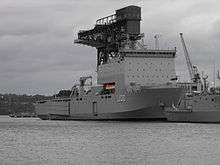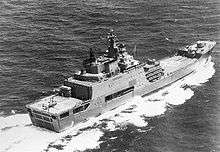Dock landing ship
.jpg)
A dock landing ship (also called landing ship, dock or LSD) is an amphibious warfare ship with a well dock to transport and launch landing craft and amphibious vehicles.[1] Some ships with well decks, such as the Soviet Ivan Rogov class, also have bow doors to enable them to deliver vehicles directly onto a beach (like a tank landing ship). Modern dock landing ships also operate helicopters.
A ship with a well deck (docking well) can transfer cargo to landing craft in rougher seas than a ship that has to use cranes or a stern ramp.[2] The US Navy hull classification symbol for a ship with a well deck depends on its facilities for aircraft – a (modern) LSD has a helicopter deck, a LPD also has a hangar, and a LHD or LHA has a full-length flight deck.[2]
History
The LSD (US Navy hull classification for landing ship, dock) came as a result of a British requirement during the Second World War for a vessel that could carry large landing craft across the seas at speed.
The predecessor of all modern LSDs is Shinshū Maru of the Imperial Japanese Army, which could launch her infantry landing craft using an internal rail system and a stern ramp. She entered service in 1935 and saw combat in China and during the initial phase of Japanese offenses during 1942.
The first LSD of the Royal Navy came from a design by Sir Roland Baker who had designed the British Landing Craft, Tank. It was an answer to the problem of launching small craft rapidly. The "Landing Ship Stern Chute", which was a converted train ferry, was an early attempt. Thirteen Landing Craft Mechanized (LCM) could be launched from these ships down the chute. The Landing Ship Gantry was a converted tanker with a crane to transfer its cargo of landing craft from deck to sea – 15 LCM in a little over half an hour.[3]
The design was developed and built in the US for the US Navy and the Royal Navy. The LSD could carry 36 LCM at 16 knots (30 km/h). It took one and a half hours for the dock to be flooded down and two and half to pump it out. When flooded they could also be used as docks for repairs to small craft.
.jpg)
.jpg)
Vessels of the LSD hull classification
In the United States Navy, two related groups of vessels classified as LSDs are in service as of 2011, the Whidbey Island and Harpers Ferry classes, mainly used to carry hovercraft (LCACs), operate helicopters, and carry Marines.[4]
The British Royal Fleet Auxiliary (RFA) operates three Bay-class landing ships based on the Dutch-Spanish Enforcer design in support of the Royal Navy's operations, while a fourth ship of the class – previously in RFA service – is now operated by the Royal Australian Navy.
Former US LSDs include the Ashland class, Casa Grande class, Thomaston class and Anchorage class.
LSD classes
In service
| Country | Class | In service | Commissioned | Length | Beam | Draft | Displacement (mt) | Note | |
|---|---|---|---|---|---|---|---|---|---|
| Choules | 1 | 2011 | 176.6 m (579 ft) | 26.4 m (87 ft) | 5.8 m (19 ft) | 17,810 | Ex-RFA Largs Bay (L3006) sold to Royal Australian Navy in April 2011, renamed HMAS Choules (L-100). |  | |
| Ceará | 1 | 1989 | 160 m (520 ft) | 26.0 m (85.3 ft) | 5.94 m (19.5 ft) | 11,989 | In reserve, ex-USS Hermitage (LSD-34) loaned to Brazilian Navy in 1989, renamed Ceará (G30), sold to Brazilian Navy in 2001. |  | |
| Hsu Hai | 1 | 2000 | 169 m (554 ft) | 26.0 m (85.3 ft) | 6.1 m (20 ft) | 14,225 | Ex-USS Pensacola (LSD-38) sold to Republic of China (Taiwan) Navy in 2000, renamed ROCS Hsu Hai (LSD-193). | _departs_San_Diego_Bay.jpg) | |
| Ivan Gren | 1 | 2016 | 120 m (390 ft) | 16.0 m (52.5 ft) | 6,600 | A second one building | .jpg) | ||
| Bay | 3 | 2007 | 176.6 m (579 ft) | 26.4 m (87 ft) | 5.8 m (19 ft) | 17,810 |  | ||
| Whidbey Island | 8 | 1985 | 186 m (610 ft) | 26.0 m (85.3 ft) | 5.94 m (19.5 ft) | 16,100 | _makes_a_wide_turn_prior_to_conducting_helicopter_operations_off_the_coast_of_the_island_of_Sumatra%2C_Indonesia.jpg) | ||
| Harpers Ferry | 4 | 1995 | 185.80 m (609.6 ft) | 26.0 m (85.3 ft) | 5.94 m (19.5 ft) | 19,600 | _approaches_Military_Sealift_Command_fleet_replenishment_oiler_USNS_Tippecanoe_(T-AO_199)_for_an_underway_replenishment.jpg) |
Decommissioned
| Country | Class | In service | Commissioned | Length | Beam | Draft | Displacement (mt) | Note | |
|---|---|---|---|---|---|---|---|---|---|
| Cándido de Lasala | 1 | 1970–1981 | 139.5 m (458 ft) | 22.0 m (72.2 ft) | 4.83 m (15.8 ft) | 7,930 | Ex-USS Gunston Hall (LSD-5) sold to Argentina in 1970 and renamed ARA Cándido de Lasala (Q-43), scrapped after 1981. |  | |
| Rio de Janeiro | 1 | 1990–2012 | 160 m (520 ft) | 26.0 m (85.3 ft) | 5.94 m (19.5 ft) | 11,989 | Ex-USS Alamo (LSD-33) loaned to Brazilian Navy in 1990, renamed Rio de Janeiro (G31). | .jpg) | |
| Chung Cheng | 1 | 1977–1985 | 139.5 m (458 ft) | 22.0 m (72.2 ft) | 4.83 m (15.8 ft) | 7,930 | Ex-USS White Marsh (LSD-8) loaned to the ROC Navy in 1960 and renamed ROCS Chung Cheng (LSD-191), scrapped 1985. | ||
| Chung Cheng | 1 | 1984–2012 | 139.5 m (458 ft) | 22.0 m (72.2 ft) | 4.83 m (15.8 ft) | 7,930 | Ex-USS Comstock (LSD-19) sold for scrapping on 17 October 1984 by MARAD, salvage by ROC Navy and commissioned in 1984, renamed ROCS Chung Cheng (LSD-191). | _underway_off_Korea_1951.jpg) | |
| Ivan Rogov | 3 | 1978–2002 | 157 m (515 ft) | 23.8 m (78 ft) | 6.7 m (22 ft) | 14,060 | Ivan Rogov and Aleksandr Nikolayev are now being preserved; Mitrofan Moskalenko was being auctioned off for scrapping in 2012.[5] |  | |
| Ashland | 8 | 1943–1969 | 139.5 m (458 ft) | 22.0 m (72.2 ft) | 4.83 m (15.8 ft) | 7,930 | Ex-USS Gunston Hall (LSD-5) sold to Argentina and scrapped after 1981 and Ex-USS White Marsh (LSD-8) sold to Taiwan and scrapped 1985; rest scrapped from 1968 to 1970. | _underway_in_Hampton_Roads_1965.jpg) | |
| Casa Grande | 13 | 1944–1970 | 139.5 m (458 ft) | 22.0 m (72.2 ft) | 4.83 m (15.8 ft) | 7,930 | Ex-USS Shadwell (LSD-15) is only ship in the class still exist and it is still in use as a test and training platform in the development of fire models and other damage and control systems, most others scrapped or sunk as target. | _underway_off_Korea_1951.jpg) | |
| Thomaston | 7 | 1954–1990 | 160 m (520 ft) | 26.0 m (85.3 ft) | 5.94 m (19.5 ft) | 11,989 | Ex-USS Alamo (LSD-33) loaned to Brazilian Navy (now decommissioned) and ex-USS Hermitage (LSD-34) loaned (now in reserve) and late sold to Brazilian Navy. |  | |
| Anchorage | 5 | 1969–2003 | 169 m (554 ft) | 26.0 m (85.3 ft) | 6.1 m (20 ft) | 14,225 | Ex-USS Pensacola (LSD-38) sold to Republic of China (Taiwan) Navy and only active ship with all others scrapped or sunk as target. | _departs_San_Diego_Bay.jpg) |
See also
References
- ↑ "Mother of Minesweepers". Popular Mechanics: 97–104, see drawings pp. 98–99. February 1952.
- 1 2 "World Wide Landing Ship Dock/Landing Platform Dock". Retrieved 2012-05-17.
- ↑ Brown 2006, p. 145
- ↑ US Navy Office of Information Fact File – LSD
- ↑
Cited literature
- Brown, D. K. (November 2006). Nelson to Vanguard. Annapolis, Maryland: US Naval Institute Press. ISBN 1-59114-602-X.
External links
| Wikimedia Commons has media related to Dock landing ships. |